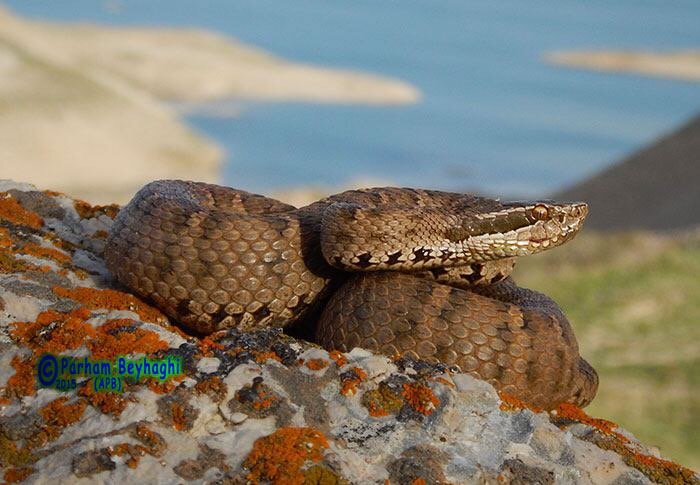Focus on Caucasian pit viper

TEHRAN — Vipers are the most efficient poisonous snakes of all. Their long fangs can inject venom deep into a victim. The venom acts mainly on the blood and muscles of the prey.
Vipers usually have short, thick bodies and triangular heads covered with small, ridged scales. There are two main groups of vipers. Pit vipers have large pits on the face and other vipers do not.
Some especial vipers such as Green bush viper (Atheris squamigera), Puff adder (Bitis adder), Sumatran pit viper (Trimeresurus sumatranus) and Rattlesnakes from (Crotalus) are known more but here in our country we have an especial pit viper whose name is Caucasian pit viper (Gloydius halys caucasicus). This magnificent snake in Iran known as Afee hofredar-e Qafqazi.
General description
Caucasian pit viper is a specific subspecies of Viperidae Family which recognized by Nikolsky in 1916. Evolution has perfected the viper family’s highly efficient and rapid method of envenomation. The unusually sophisticated bone structure of the head and long, hollow, recurved fangs of vipers have a great role on their successful hunt.
Caucasian pit viper has narrow snout and extended upward at the tip; large, distinct scales on dorsal surface of head; pupils vertical; tail short with vibratory movements similar to Rattle Snakes. Body yellow-grey, red or light brown; dorsally ocelli or dark transverse bars, laterally one or two series of dark spots; dark snout; posteriorly, head with two diagonal dark stripes, temporal region with pale-edged dark spot, venter dark or with grey or brown spots.
Caucasian pit viper favorite places are scrublands, mountains, hills, forests and even under rocks. Maximum length of Caucasian pit viper is 67 cm and tail is about 6 cm. Diet of this snake is quite typical: Amphibians (frogs), small rodents and lizards Amphibians (frogs), small rodents and lizards are the best choices.
Distribution mainly in Iran
The species main range is from the Northeast coasts of the Caspian Sea towards the steppes of Kazakhstan, North Turkmenistan, North Uzbekistan, Kyrgyzstan, North Tajikistan, and Northewest China, most of Mongolia, Northwest Manchuria, and South Siberia.
Isolated subranges in South Caspian Sea, Northeast Iran, South Turkmenistan and Northwest and Northeast Afghanistan, Gansu, Southeast Mongolia, North Shanxi and Hebei provinces in China. Chorotype is Turanian plus Eastern Palearctic. G.h.caucasicus is reported from Southeast Azerbaijan, North Iran, South Turkmenistan and Northwest Afghanistan.
Caucasian pit viper is widespread in Iran. This subspecies recorded in Semnan, Tehran, Alborz, Qazvin, Gilan, Mazandaran, Golestan, North Khorasan and Khorasan Razavi Provinces. It is also common in Lar Damavand, Afjheh, Firooz Mountain, Khan Ahmad, Kandavan, Taleqan, Borqan, Roodbar, Chehel Dokhtar, Gonbad Kavoos, Gorgan and Kalardasht.
Affinities
No comprehensive molecular phylogenetics have been provided so far for Gloydius. The genus Gloydius was for longtime included in Agkistrodon (now considered exclusive of North and Central America). Researchers by morphological character analysis (1981) and molecular tests confirmed Caucasian pit viper as a Gloydius halys caucasicus. So any other names aren’t scientific.
Conservation situation
Population of Caucasian pit viper in Iran, estimated average but it hasn’t scientific basis. International Union for Conservation of Nature and Natural Resources (IUCN) not listed this subspecies till now. This subspecies also is not listed on Convention on International Trade in Endangered species of wild Fauna and Flora (CITES). Comprehensive and detailed studies about this subspecies is really important in Iran because raises some novel issues at the intersection of scientific research, conservation efforts and so on.
Some interesting points
Caucasian pit viper is venomous and the only member of Crotalinae sub-family in Iran. But there are many differences between Caucasian pit viper and their relatives: Rattlesnakes.
Rattlesnakes are best known for, and most easily recognized by, their rattle. The rattlesnake babies are born with what is called a pre-button. The baby snake loses this piece when it sheds its skin for the first time. With the shedding a new button appears. But Caucasian pit viper doesn’t have this piece although it makes noises by different mechanism.
Aside from this pair of simple eyes, Caucasian pit viper just like rattlesnakes are able to detect thermal radiation emitted by warm-blooded organisms in their environment.
Functioning optically like a pinhole camera eye, thermal radiation, in the form of infrared wavelength light, enters, passes through the opening of the pit and strikes the pit membrane located in the back wall, warming this part of the organ.
Due to the extremely high density of these heat-sensitive receptors innervating this membrane, the rattlesnake can detect temperature changes of 0.003 °C or less in its immediate surroundings.
Infrared cues from these receptors are transmitted to the brain by the trigeminal nerve, where they are used to create thermal maps of the snake’s surroundings. Due to the small sizes of the pit openings, typically these thermals images are low in resolution and contrast. Nevertheless, rattlesnakes superimpose visual images created from information from the eyes with these thermal images from the pit organs to more accurately visualize their surroundings in low levels of light. This mechanism helps them not just for seeing but also for hiding better.
